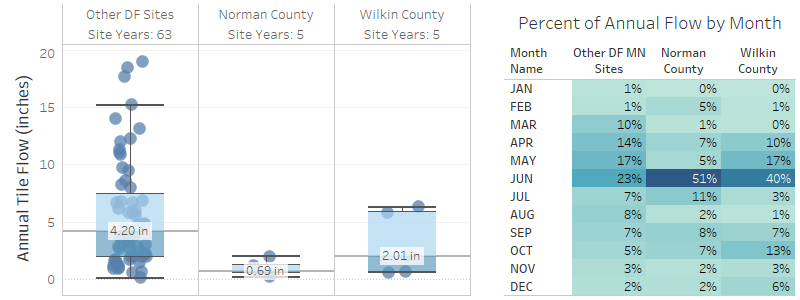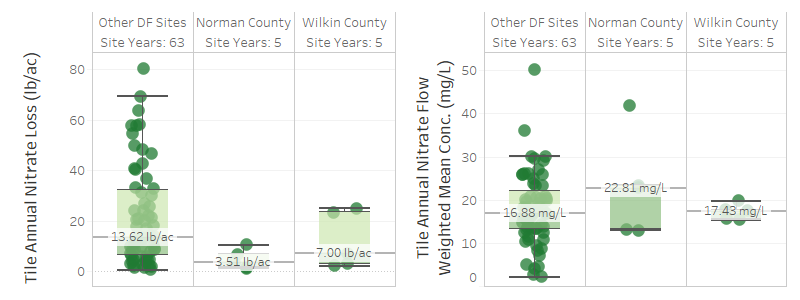There have been 12 core farm projects in Minnesota. Two of the sites, Norman County and Wilkin County, are in the Red River of the North Watershed. While there are surface runoff and tile flow sites at other locations, only tile flow is monitored at these two sites. Both the Norman and Wilkin County sites are recently installed pattern tile systems with 60-80’ spacing, 4’ depth, and lift pumps. Data has been collected at the Norman and Wilkin County sites from 2013 through 2017. Data collected at these two sites highlights the importance of local data when discussing water quality and agricultural practices.
Precipitation and Tile Flow
The amount of precipitation affects the amount of tile flow. In general, higher precipitation corresponds to higher flow (figure below). Precipitation at Norman and Wilkin County locations was below normal in 2013 and 2015 and near normal in 2014 and 2016. In, 2017 precipitation was above normal at Wilkin County and below normal in Norman County.
Tile flow at Norman and Wilkin County sites was generally lower than other Discovery Farms Minnesota sites (figure below). Tile flow has been lower because precipitation amounts have been lower. Sites in Southern Minnesota have higher amounts of drainage due to higher amounts of precipitation. On average, there is about 6-10 inches less precipitation in Northwestern Minnesota compared to Southern Minnesota which leads to lower drainage amounts and lower sediment and nutrient losses.
The timing of tile flow at the Norman and Wilkin County sites was delayed compared to tile flow in other parts of Minnesota (table above). Most of the flow at the Norman and Wilkin County sites was in May and June while other Disocvery Farms sites typically have significant flow from March through June.
Soil and Phosphorus Loss
Soil and phosphorus loss are mostly transported by surface runoff across the Discovery Farms monitoring network in Minnesota. The amounts of soil and phosphorus transported by tile drainage systems in Minnesota is relatively low compared to surface runoff.
The amount of soil and phosphorus loss at Norman and Wilkin County tile sites was below the median values for tile drainage sites (figures below). Modern design of the tile systems at Norman and Wilkin Counties, including plastic corrugated pipe and no surface intakes, limit the amount of soil that moves into the tile system. Reduced soil movement in the tile systems also lowers particulate phosphorus attached to soil particles. Low soil test phosphorus values, both Norman and Wilkin County sites are below 10 ppm, limit the amount of dissolved phosphorus available to move into the tile system. Both these factors lead to lower total phosphorus movement.
Nitrogen Loss
Nitrogen loss is mostly transported by tile drainage across the Discovery Farms monitoring network in Minnesota. The amount of nitrogen transported by surface runoff in Minnesota is relatively low compared to tile drainage. Over 90% of the nitrogen loss in tile systems is in the nitrate nitrogen form.
The amount of nitrate loss at Norman and Wilkin County tile sites was below the median value for tile drainage sites except for Wilkin County in 2014 and 2017 (figure below on the left). Nitrogen losses typically follow the amount of drainage, meaning that more drainage usually equals more nitrogen loss. The low nitrogen losses at the Norman and Wilkin County sites compared to other Discovery Farms sites in Minnesota are mostly a consequence of lower drainage amounts as nitrate concentrations of the tile samples were similar (figure below on the right).
- Lessons Learned from Schafer Farms – Implementing Conservation in a Rolling Landscape - April 8, 2020
- What happened to spring? - July 15, 2019
- Tile flow and nutrient movement in Northwest Minnesota - September 13, 2018




